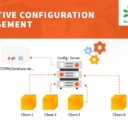
In Microservices architecture, applications are built with a collection of modules that work independently from each other. These modules are interdependent, but the main idea is to use loose-coupling. Microservices coordinate with the means of communication. This basically means that each module sits differently and deployed independently, and the DevOps team will be working on the continuous delivery of each module.
But the main question here is, how can we make Microservices talk?
Now making microservices talk and communicate is not as simple as you think. Multiple factors such as throughput, latency, and scalability have to be considered. The most common modes of communication used by developers are Synchronous (blocking) and Asynchronous (non-blocking). But to be honest, both of these are more like characteristics of a programming language. Let’s dive into some of the most easy-to-use communication methods in a cloud architecture.
The Brokerless Design: By using the brokerless design, we can make microservices communicate directly with each other. Either HTTP or WebSocket can be used for streaming here. Since there are no intermediary nodes, you can directly connect to services. Provided you know the service address and API used there.
- The pros – This method is fast and has the lowest latency possible, easy to implement, easy to debug, and most of the database API’s can actually use this method
- The cons – The brokerless design comes with a few cons as well. Connection issues, service mechanisms scalability, and since the modules are closely grouped, making modifications can be time-consuming.
The Messaging Bus Design : Unlike the Brokerless Design, here the communication is done through a broker. Each microservice module connects to a broker and can send and receive messages through the same broker. The service sending messages are called as“Publisher” and the receiver is known as a “Subscriber”.
- The pros – Most messaging brokers support load balancing, service discovery is not required, and the messaging backend makes it easy to distribute the workload.
- The cons – Scaling the brokers, higher rate of latency, and needs high resource usage.Choosing the right mode of communication is a fundamental decision which needs to be taken by thorough research, for best practices on how to make microserives communicate
Microservices Blogs
DevOps is the most recent tech absorption in enterprises with close sync between software development and IT operations…
Problem statement Before the advent of Microservices, we used to create a properties files in which we maintained…
As we all know, Microservices brought in a paradigm shift in the way we think, design and architect…
In my recent articles, I covered the core building blocks of DevOps in Microservices and Pitfalls of each…
In my previous article, I covered the core building blocks of DevOps in Microservices environment. As part of…




